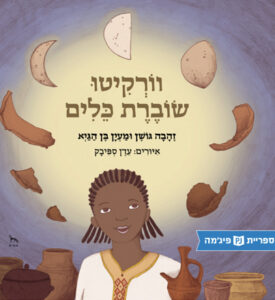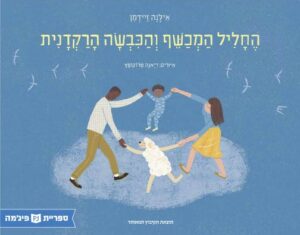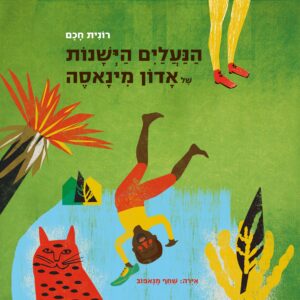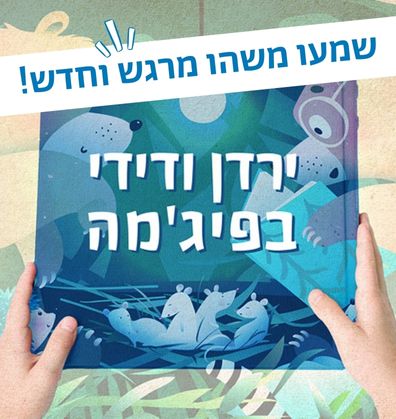מְקוֹרוֹת וְתַרְבּוּת
יהדות אתיופיה
החברה הישראלית היא פסיפס של תרבויות. ספרים העוסקים ביהדות אתיופיה הם שער כניסה לעולם ומלואו; האוכל המיוחד, חג הסיגד, המוזיקה והמנהגים הייחודים, הם אשנבים עבורנו לתרבות האתיופית ששורשיה נטועים עמוק באפריקה וענפיה ממשיכים לצמוח בישראל. בעזרתם אנחנו מתקרבים, מכירים ומרכיבים את הסיפור המשותף שלנו. בספרים שלפניכם תוכלו למצוא מעשיות שעוברות מדור לדור, מנהגי חג, וסיפורי עלייה, שכל אחד מהם הוא חלק מהעושר התרבותי העצום של יהדות אתיופיה.
סְּפָרִים
Book-Related Family Activities
Discussion
How do you prepare for Pesach? Do you have a family tradition that has been passed on from one generation to the next? Perhaps you would like to discuss it with your child. You could tell them how you, parents, celebrated Pesach when you were growing up, sharing a family custom or story with them that has stayed with you all these years.
About a dish
Do you have a dish at home that is associated specifically with Pesach? How about looking at it together, and telling its story: Where did it come from? Why was it kept by your family? What is it used for during Pesach?
Illustrations tell stories
What can we learn from the illustrations in this book? Do they help us imagine Workito’s and Almaz’s lives in Ethiopia? You may enjoy choosing a certain illustration, looking at it together and discussing which character you would be interested in chatting with, what you would ask this character, and whether you would like to join him/her.
In with the new
Following Workito’s story, you may want to touch up items you love that are now tattered or torn. You could draw on an old t-shirt, color an old hat, cover an old planter with a mosaic, decorate some kitchenware, or create a completely new item from a broken dish. Do you like the way it turned out?
Discussion
Following the childhood story the father tells his child in this book, you could also share memories and stories from your own childhood with your child: Where did you grow up? What did you like doing? Which songs and stories accompanied you? What were your hobbies? Did you have any household chores or special roles to play within your family? Perhaps you had some pets?
You could also look at the illustrations in the book, choose your favorite one, and share your choice with each other.
A family story
How about asking some family members to share their stories of life transitions with you? Which countries have they lived in? how did they end up in Israel, and how was their absorption? Did they move into a new community upon making Aliyah? You could act the stories you were told out, or tell them using a song and dance.
A magical tune
Melodies can have a profound effect on us. In the spirit of this book, you could listen to different tunes together, close your eyes, “enter” the melody, and dance to it.
Jerusalem of Gold
At the end of the book, Jerusalem is depicted as golden, just as it was in the Ethiopian immigrants’ dreams. The phrase ‘Jerusalem of Gold’ was mentioned in Jewish scripture as the name of the golden jewel that Rabbi Akiva gave his wife, etched with the image of Jerusalem. Inspired by it, Naomi Shemer wrote the lyrics and music to her song, so entitled, which became one of the most well-known and loved Israeli songs. Perhaps you could ask your child why they think Jerusalem was called that, listen to the famous song together, or play it as an ensemble.
Family Activities:
1. Noa is very attached to the old doll that her grandmother made for her, but also likes new dolls and toys. You can ask your children which dolls and toys they like in particular, and remind them who gave them the gifts and under which circumstances.
2. Mr. Minasa tried to get rid of his old shoes when he arrived in the new country. You can play an imaginary game with your children: If you were leaving for a faraway place, what would you take with you and what would you leave behind?
3. Like Grandmother Agarnesh, you too can craft a hand-made doll for your child, using old socks and clothing. You are invited to send us a photograph of the doll, which we will happily post on the Sifriyat Pijama website!
4. Mr. Minasa arrived in the new country from Ethiopia. Where did your family originate? This is an opportunity to share your personal immigrant story with your children, and show them photographs of the old country. Perhaps you too have old bjects or clothing that you can search for together.
5. Mr. Minasa’s neighbors recognized his old shoes and returned them to him. Did you ever find something and return it to its owner? Was the owner happy to receive the lost object?
6. You can act out the story with your children. Each one in turn takes on the role of Mr. Minasa and looks for places around the house to hide the shoes. The other player finds them and declares, “Oh, here are Mr. Minasa’s old shoes!”

 Workito Breaks the Dishes
Workito Breaks the Dishes  The Magic Flute and the Dancing Sheep
The Magic Flute and the Dancing Sheep  An Old Pair of Shoes
An Old Pair of Shoes 
